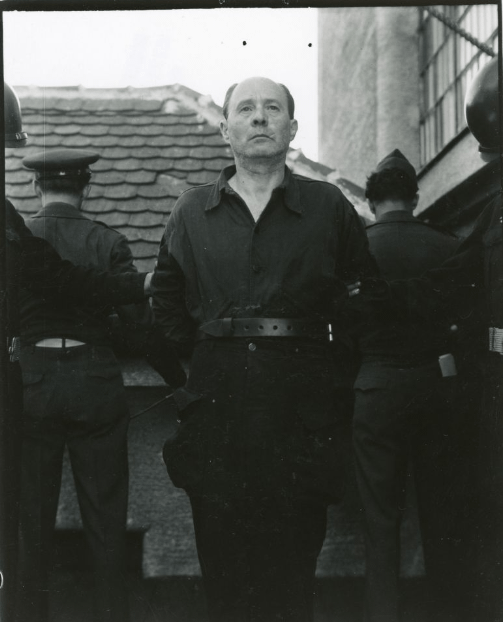
The last photo of SS officer Fritz Dietrich, 50. He had a leading role in the massacres of thousands by Germans and Latvian collaborators in Liepāja. Dietrich, whose role in this was not known at the time, was hanged for the murders of 7 American POWs in Germany (Landsberg Prison, 1948) [903 x 622].
by lightiggy

1 Comment
[Fritz Dietrich](https://en.wikipedia.org/wiki/Fritz_Dietrich_(Nazi))
[Liepāja massacres](https://en.wikipedia.org/wiki/Liep%C4%81ja_massacres)
On July 31, 1944, after an air raid three American airmen were forced to parachute from their disabled plane. They were taken into custody and jailed at the police stations of Malstadt, Burbach and Neunkirchen. When Fritz Dietrich – police president of Saarbruecken – heard about the captured fliers, he ordered them to be picked up and shot. The flyers were taken to the woods and shot. One of the victims was found alive the next morning and it was ordered that the wounded flyer be killed by injections. As this failed to kill the victim, he was later shot dead. After another air raid, a few weeks later, four American airmen, who had been forced to parachute from their disabled plane were taken into custody by the Burbach police. Again, on orders of Dietrich, the fliers were picked up and shot in the woods.
[The United States of America vs. Fritz Dietrich, et al.](https://web.archive.org/web/20230127041101/https://www.online.uni-marburg.de/icwc/dachau/000-012-1545.pdf)
In 1947, Dietrich and 7 others were tried for war crimes by an American military tribunal. On July 15, 1947, the court found Dietrich and five others guilty. The others were SS colonel Willy Stemmler, SS lieutenant Karl Hunsicker, SS sergeant Fritz Dintinger, SS corporal Albert Eli, and Dr. Otto Zeitzer, also an SS sergeant. During the trial, Dintinger had made a full confession. He told the court that he, Hunsicker, and Eli had participated in the first three murders under orders from Stemmler. He said he and Eli had each directly participated in the murders of a single airmen, but that Hunsicker had taken a leading role in the murders of all three victims. Zeitzer had injected one airman with “two very strong shots.” The court believed him. Duntinger’s confession matched almost perfectly with the military’s initial investigation of the crime.
Hunsicker taking initiative was consistent with the fact that only he, Dietrich, and Stemmler were implicated in the murders of the four other airmen.
The tribunal sentenced Fritz Dietrich, Willy Stemmler, and Karl Hunsicker to death by hanging, Fritz Dintinger and Albert Eli to life imprisonment, and Otto Zeitzer to four years imprisonment. [On appeal](https://www.legal-tools.org/doc/2020e3/pdf/), it was found that Zeitzer had wanted to help the prisoners and only superficially followed the orders. The injection failed to kill the victim since Zeitzer never intended to kill him. As such, his conviction was overturned and he was released from custody in February 1948. The verdicts and sentences for the others were upheld.
Dintinger and Eli would benefit from the pressure to grant early release to Nazi war criminals upon the start of the Cold War. Some time in the early 1950s, the sentences of Dintinger and Eli were each commuted to 30 years. They were both released from prison in the fall of 1954.
Their more enthusiastic superiors were less fortunate.
In early 1948, a blanket stay of execution was granted for nearly all Nazi war criminals on death row in the U.S. occupation zone, due to pressures related to false allegations of torture, now proven to have been false, and other political considerations. The reprieve was briefly lifted for most of them in October 1948, but reinstated in April 1949. The military governor of U.S. occupation zone of Germany, Lucius Clay, correctly predicted that as time passed, pressure to commute the death sentences would greatly increase.
As soon as the blanket reprieve for most of the death row inmate was removed, Clay, who had repeatedly asked for it be lifted, embarked on a spate of last-minute mass executions. Between October 1948 and March 1949, another 104 Nazi war criminals were executed in the U.S. occupation zone of Germany. Fritz Dietrich, 50, was hanged on October 22, 1948. Willi Stemmler, 49, and Karl Hunsicker, 39, were hanged on October 29, 1948.
Fritz Dietrich, a Nazi fanatic who’d participated in the July Putsch in 1934, never confessed to his role in the Liepāja massacres prior to his execution. He never admitted his guilt to the murders of the prisoners, either. During his trial, he claimed that he never issued any orders to murder the airmen. He said he would never do this and had been shocked upon learning about the murders. Even without knowing the full extent of his crimes, however, the court had seen Dietrich for his true colors, a liar and a cold-blooded mass murderer.
A defiant Dietrich maintained his innocence to the end:
>”In the conviction that my death for my passionately beloved fatherland, for which I worked and fought my entire life, will ultimately be of service, I go this last walk of sacrifice with a proud heart because I know that my sacrifice will contribute to fill the measure of suffering that has been imposed by a cruel victor over the German people without compelling reason.”